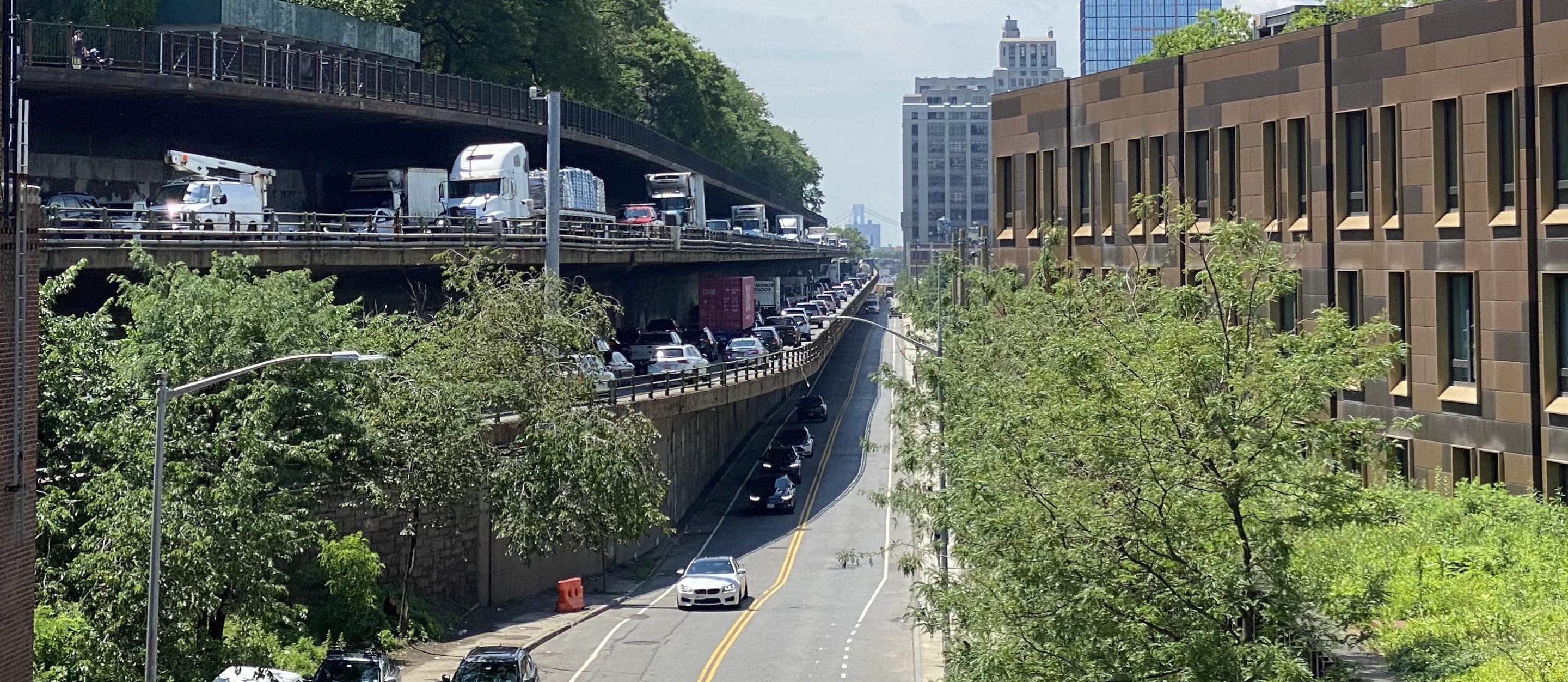Left hand, meet right.
The city Department of Transportation is engaging in a behind-the-scenes effort to solicit support for its bid for nearly $1 billion in federal infrastructure bucks to fix the Brooklyn-Queens Expressway — a highway that the agency admits is one of Robert Moses's greatest mistakes, Streetsblog has learned.
The undated "sign-on" letter to U.S. Secretary of Transportation Pete Buttigieg functions as talking points for would-be supporters. It's being distributed to community group leaders and local pols to bolster the agency's effort to get $800 million to help “repair and enhance a vital part of the Brooklyn-Queens Expressway” — specifically, the 1.5-mile long section between Atlantic Avenue and Sands Street that includes the crumbling triple cantilever.
The letter wants to have Moses's cake and eat it, too. The DOT admits that the highway “divided communities across its path,” but it also seeks the cash to maintain the roadway's structural integrity indefinitely, calling the BQE the “poster child of American highway neglect.”
“A major repair is needed to ensure the safety and continued lifespan of the structure,” the letter added.
The sign-on campaign comes just days after a coalition of civic groups penned its own letter, calling on Mayor Adams to do the exact opposite and scrap his "car- and truck-centric" plan to repair the BQE for another two generations in favor of one that gets New Yorkers out of cars and onto transit.
In an era of highway teardowns and "reconnecting community" initiatives, the Adams administration is simply misguided, advocates believe.
“It’s sad to see the city’s text invoking the negative history of urban highway construction while seeking to cement that legacy for the rest of the 21st century,” said Jon Orcutt, a former city transportation official. “Let’s hope U.S. DOT (and our Congressional delegation) takes into account the significant concerns recently expressed by Brooklyn and citywide civic leaders in evaluating the city’s application.”
This is great. Just say no to $800M in federal funding for this lame urban highway plan @NydiaVelazquez @StreetsblogNYC https://t.co/7FXpgvI7nb
— Jon Orcutt (@jonorcutt) August 18, 2023
It’s unclear if any organizations are planning to sign on; Brooklyn Heights Association Executive Director Lara Birnback told Streetsblog that she and several other groups that are part of the DOT's so-called Community Visioning Council for the BQE project have received the letter.
The support letter also comes less than two weeks after City Comptroller Brad Lander chastised the state for spending too much of its federal dollars from the 2021 infrastructure bill on highway expansion projects like the widening of Van Wyck Expressway.
The triple cantilever section of the BQE is at risk of collapse. It carries more than 130,000 vehicles a day, 13,000 of which are trucks — numbers that would horrify the highway's original builders. The previous administration’s plan was to shore up the roadway by waterproofing it, banishing overweight trucks, and making interim repairs.
But when Mayor Adams took over, he charted a new path. Rather than buying time to reimagine the entirety of the BQE, the Adams administration wants to seize a “once-in-a-generation opportunity,” with the help of federal funding, to rebuild the triple cantilever now. And as part of its plans, the city unveiled late last year three fairly similar design options for the rebuild that all include green space on top in order to conceal the highway and connect to the promenade above and Brooklyn Bridge Park down below.
The DOT has yet to decide what exactly that will look like — though the city has signaled that it's leaning towards a full six-lane rebuild that would likely expand the highway's geographic footprint.
The money for which the city is asking would come from the US DOT’s Multimodal Project Discretionary Grant Program, as part of the Adams administration's larger $1.5-billion infrastructure agenda, the news website The City reported. And the money would go towards not only repairing the highway, but also towards "enhancing safety for pedestrians and cyclists," according to the DOT, a reference to its much-panned designs for the Atlantic Avenue interchange.
Failing to improve public transit is a non-starter, said Danny Pearlstein of Riders Alliance.
“We really can't afford to repeat mistakes like the Van Wyck. We need every possible opportunity to improve transit and reduce driving,” said Pearlstein. “If we are using federal infrastructure dollars, we should be doing it in a way that reduces vehicle miles traveled and gives people more and better transit options. The city’s own busway model could be of use on the BQE.”
The DOT did not respond to a request for comment.






